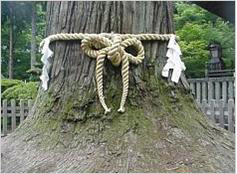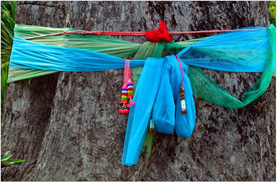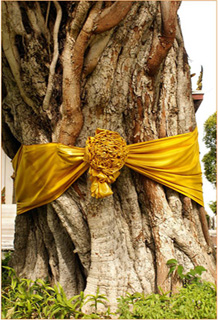Reclaiming the Ancient Tradition of Tree Wrapping by Jan Johnsen
 Our modern insulated lifestyle with its technological advances has diminished our contact with the earth and we are now virtually cast adrift, isolated from the strength and resilience that trees can offer us. We spend such little time amongst these grand woody beings that we have lost – unknowingly – an important stabilizing and grounding anchor for our psyche. This changes once we remember to honor the energy that trees emanate. The Zen master, T. D. Suzuki, wrote in his book, Zen and Japanese Culture “Every old tree of any sort inspires a beholder with a mystic feeling which leads him to a faraway world of timeless eternity.” One way to encourage all to ‘behold the trees’ is by celebrating certain trees in our midst through an ancient custom I call tree wrapping.
Our modern insulated lifestyle with its technological advances has diminished our contact with the earth and we are now virtually cast adrift, isolated from the strength and resilience that trees can offer us. We spend such little time amongst these grand woody beings that we have lost – unknowingly – an important stabilizing and grounding anchor for our psyche. This changes once we remember to honor the energy that trees emanate. The Zen master, T. D. Suzuki, wrote in his book, Zen and Japanese Culture “Every old tree of any sort inspires a beholder with a mystic feeling which leads him to a faraway world of timeless eternity.” One way to encourage all to ‘behold the trees’ is by celebrating certain trees in our midst through an ancient custom I call tree wrapping.
The tradition of wrapping tree trunks or adorning branches of special trees is a visual statement that says, “We honor this tree and respect its vital presence.” It is often done with fiber rope, natural ribbon, or fabric and it is used to highlight unusual trees, as a supplication and/or protective measure.
 Tree wrapping has been practiced for thousands of years in countries across the world. In Japan, it has been elevated to an art form and derives from the Japanese Shinto belief that all natural forms are imbued with spirit. Their tradition consists of wrapping the trunks of specially honored trees with a braided and twisted rope called a ‘shimenawa’. This rope, made from rice straw with a unique left hand twist, holds white zigzag paper streamers called ‘shide’ which act as protectors for the tree’s spirit or kodama. Joseph Campbell, in his landmark book, Hero with a Thousand Faces, refers to the shimenawa as an ‘august rope of straw,’ and “one of the most conspicuous, important and silently eloquent, of the traditional symbols…of Japan.” In a fitting gesture of renewal, each New Year the shimenawa are burned on a community bonfire and are replaced with new ones. What a lovely New Year’s tradition!
Tree wrapping has been practiced for thousands of years in countries across the world. In Japan, it has been elevated to an art form and derives from the Japanese Shinto belief that all natural forms are imbued with spirit. Their tradition consists of wrapping the trunks of specially honored trees with a braided and twisted rope called a ‘shimenawa’. This rope, made from rice straw with a unique left hand twist, holds white zigzag paper streamers called ‘shide’ which act as protectors for the tree’s spirit or kodama. Joseph Campbell, in his landmark book, Hero with a Thousand Faces, refers to the shimenawa as an ‘august rope of straw,’ and “one of the most conspicuous, important and silently eloquent, of the traditional symbols…of Japan.” In a fitting gesture of renewal, each New Year the shimenawa are burned on a community bonfire and are replaced with new ones. What a lovely New Year’s tradition!
The Europeans, too, practice tree wrapping, of sorts in their annual Maypole dance. This festive community occasion celebrates the most fruitful time of year around a pole (taken from a hawthorn, maple or birch tree) decorated with green leaves and branches to simulate a tree. The Maypole dance of Sweden takes place at the summer solstice. Several long colored ribbons are suspended from the top of the pole and the celebrants, each holding the end of a ribbon, weave in and around each other until the ribbons are woven together around the ‘tree’, meeting at the base.
 It is believed that the Maypole celebration derives from the Siberian custom of tying narrow fabric bands or ceremonial silk scarves to the branches of a vigorous tree. This tree now serves as a prayer tree, an intermediary with the invisible world, and each band transmits prayers for peace of the world and personal peace. A variation of this tradition is also practiced in India where local villagers pay tribute to the goddess, Devi, by similarly adorning tree branches in her sacred grove.
It is believed that the Maypole celebration derives from the Siberian custom of tying narrow fabric bands or ceremonial silk scarves to the branches of a vigorous tree. This tree now serves as a prayer tree, an intermediary with the invisible world, and each band transmits prayers for peace of the world and personal peace. A variation of this tradition is also practiced in India where local villagers pay tribute to the goddess, Devi, by similarly adorning tree branches in her sacred grove.
It is clear that the activity of tree wrapping is a lovely way to celebrate our arboreal neighbors but it is more than this– wrapping the trunk or branches of a tree reminds others of the ‘message of the trees’. When we wrap the trunks of our beloved trees, we are subtly advocating a kind of tree awareness which in turn promotes an active stewardship of the trees in our midst.
 By wrapping certain trees we are re-establishing a respectful partnership between people and plants. This timely endeavor is not some ‘feel good’ activity but a call to remember the ancient understanding of the power of trees. We will in time see, as noted by Pierre Teilhard de Chardin,(video) that “…we have only to go a little beyond the frontier of sensible appearances in order to see the divine welling up and showing through.”
By wrapping certain trees we are re-establishing a respectful partnership between people and plants. This timely endeavor is not some ‘feel good’ activity but a call to remember the ancient understanding of the power of trees. We will in time see, as noted by Pierre Teilhard de Chardin,(video) that “…we have only to go a little beyond the frontier of sensible appearances in order to see the divine welling up and showing through.”
 Ms. Johnsen was named 2003 Instructor of the Year by the New York Botanical Garden. She has also received an AICP achievement award and a Progressive Architecture (PA) award for rooftop greenhouses in NYC. Jan has several books to her credit – her book, Ortho’s All About Trees, is published by Meredith Publishing. She is an engaging speaker and gives talks and workshops throughout the U.S. on the true healing power in plants and places.
Ms. Johnsen was named 2003 Instructor of the Year by the New York Botanical Garden. She has also received an AICP achievement award and a Progressive Architecture (PA) award for rooftop greenhouses in NYC. Jan has several books to her credit – her book, Ortho’s All About Trees, is published by Meredith Publishing. She is an engaging speaker and gives talks and workshops throughout the U.S. on the true healing power in plants and places.
